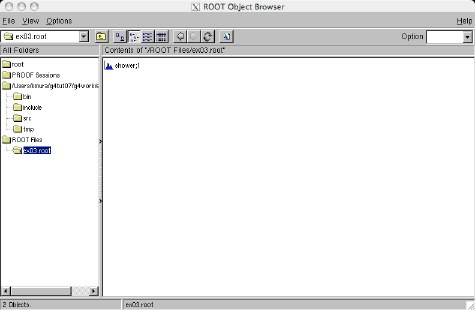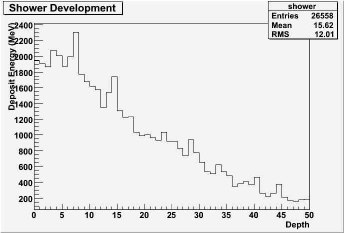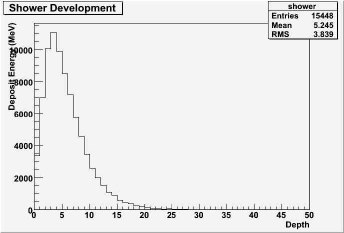Exercise-3
この演習では、exampleN03のサンプリングカロリメータを使って、Sensitive Detectorの記述を練習します。 ROOTを使ったヒストグラミングを行って、shower developmentの様子を調べてみましょう。 exampleN03では、SteppingActionを使って、カロリメータ内のエネルギー損失を処理しています。 しかし、大きなシステムでは、すべてのstepでSteppingActionが呼ばれるのは非効率です。 そこで、Sensitive Detectorを定義して、sensitive detector内でのみ、処理を行うようにします。

教材のダウンロード
ここから、演習コードをダウンロードし、作業ディレクトリに展開します。
$ cd ~/g4work/ $ tar zxvf (somewhere)/exercise-3.tar.gz $ cd exercise-3 $ ls GNUmakefile ex03.cc gun.mac include/ src/ vis.mac
Step1: コンパイルと実行
まずは、プログラムをコンパイルして、実行してみます。
$ make ... $ ./bin/Linux-g++/ex03 ... ex03(Idle)[/]:/control/execute vis.mac
ここでは、exampleN03のジオメトリを元にしています。 Gapの層 Scintillator 5mm厚、Absorber層 Pb 5m厚で、50層としています。
$ cat src/ExN03DetectorConstruction.cc
...
ExN03DetectorConstruction::ExN03DetectorConstruction()
:AbsorberMaterial(0),GapMaterial(0),defaultMaterial(0),
solidWorld(0),logicWorld(0),physiWorld(0),
solidCalor(0),logicCalor(0),physiCalor(0),
solidLayer(0),logicLayer(0),physiLayer(0),
solidAbsorber(0),logicAbsorber(0),physiAbsorber(0),
solidGap (0),logicGap (0),physiGap (0),
magField(0)
{
// default parameter values of the calorimeter
AbsorberThickness = 5.*mm; // %%%%%%%%%%%%%%%%%
GapThickness = 5.*mm; // %%%%%%%%%%%%%%%%%
NbOfLayers = 50; // %%%%%%%%%%%%%%%%%
CalorSizeYZ = 10.*cm;
ComputeCalorParameters();
// materials
DefineMaterials();
SetAbsorberMaterial("Lead");
SetGapMaterial("Scintillator"); // %%%%%%%%%%%%%%
$ cat gun.mac /gun/number 1 #/gun/particle e+ /gun/particle pi+ /gun/energy 1 GeV /gun/position -26. 0. 0. cm /gun/direction 1. 0. 0.
では、走らせてみます。1GeVのpi+を1,000イベント生成します。
$ ./bin/Linux-g++/ex03 ... ex03(Idle)[/]:/control/execute gun.mac ex03(Idle)[/]:/run/beamOn 1000 ex03(Idle)[/]:exit
プログラムが終了すると、
$ root
*******************************************
* *
* W E L C O M E to R O O T *
* *
* Version 5.14/00e 29 March 2007 *
* *
* You are welcome to visit our Web site *
* http://root.cern.ch *
* *
*******************************************
FreeType Engine v2.1.9 used to render TrueType fonts.
Compiled on 14 May 2007 for macosx with thread support.
CINT/ROOT C/C++ Interpreter version 5.16.16, November 24, 2006
Type ? for help. Commands must be C++ statements.
Enclose multiple statements between { }.
root [0] a=TBrowser()
(class TBrowser)73356128
root [1]



Step2: Hitクラスの定義
それでは、どのように実装されているか見ていきましょう。
まずは、各Scintillator層でのエネルギー損失を記述するHitクラス(
$ cat include/CalHit.hh
#include "G4VHit.hh"
#include "G4THitsCollection.hh"
#include "G4Allocator.hh"
class CalHit : public G4VHit {
private:
G4int id; <-------
G4double edep; <-------
public:
CalHit();
CalHit(G4int aid, G4double aedep);
virtual ~CalHit();
// copy constructor & assignment operator
CalHit(const CalHit& right);
const CalHit& operator=(const CalHit& right);
G4int operator==(const CalHit& right) const;
// new/delete operators
void* operator new(size_t);
void operator delete(void* aHit);
// set/get functions
void SetID(G4int aid) { id = aid; }
G4int GetID() const { return id; }
void SetEdep(G4double aedep) { edep = aedep; }
G4double GetEdep() const { return edep; }
// methods
virtual void Draw();
virtual void Print();
};
さらに、Hitオブジェクトは、 イベント毎にクリア(delete)されるので、ヘタなコンパイラだとガーベジコレクションされず、 メモリリークの原因になります。そこで、Geant4ではG4Allocatorという特別なallocatorが用意されていて、 Hitクラスのnew/deleteには、このallocatorを使います。
extern G4Allocator<CalHit> CalHitAllocator; // オブジェクトの実態は、CalHit.ccの方にある。
inline void* CalHit::operator new(size_t)
{
void* aHit= (void*)CalHitAllocator.MallocSingle();
return aHit;
}
inline void CalHit::operator delete(void* aHit)
{
CalHitAllocator.FreeSingle((CalHit*) aHit);
}
ついでに、
typedef G4THitsCollection<CalHit> CalHitsCollection;
Step3: SensitiveDetectorの記述
次に、SensitiveDetector(SD)の記述をみてみます。
$ cat include/CalorimeterSD.hh
...
enum { NCHANNEL=50 };
class CalorimeterSD : public G4VSensitiveDetector {
private:
CalHitsCollection* hitsCollection;
G4double edepbuf[NCHANNEL]; // buffer for energy deposit <---
public:
CalorimeterSD(const G4String& name);
virtual ~CalorimeterSD();
// virtual methods
virtual G4bool ProcessHits(G4Step* aStep, G4TouchableHistory* ROhist);
virtual void Initialize(G4HCofThisEvent* HCTE);
virtual void EndOfEvent(G4HCofThisEvent* HCTE);
virtual void DrawAll();
virtual void PrintAll();
};
では、実装の中身(
//////////////////////////////////////////////////
CalorimeterSD::CalorimeterSD(const G4String& name)
: G4VSensitiveDetector(name)
//////////////////////////////////////////////////
{
collectionName.insert("calorimeter");
}
/////////////////////////////////////////////////////
void CalorimeterSD::Initialize(G4HCofThisEvent* HCTE)
/////////////////////////////////////////////////////
{
// create hit collection(s)
hitsCollection= new CalHitsCollection(SensitiveDetectorName,
collectionName[0]);
// push H.C. to "Hit Collection of This Event"
G4int hcid= GetCollectionID(0);
HCTE-> AddHitsCollection(hcid, hitsCollection);
// clear energy deposit buffer
for (G4int i=0; i<NCHANNEL; i++) edepbuf[i]=0.;
}
続いて、
///////////////////////////////////////////////////////
G4bool CalorimeterSD::ProcessHits(G4Step* astep,
G4TouchableHistory* )
///////////////////////////////////////////////////////
{
// get step information from "PreStepPoint"
const G4StepPoint* preStepPoint= astep-> GetPreStepPoint();
G4TouchableHistory* touchable=
(G4TouchableHistory*)(preStepPoint-> GetTouchable());
// accumulate energy deposit in each scintillator
G4int id= touchable-> GetReplicaNumber(1);
edepbuf[id]+= astep-> GetTotalEnergyDeposit();
return true;
}
/////////////////////////////////////////////////
void CalorimeterSD::EndOfEvent(G4HCofThisEvent* )
/////////////////////////////////////////////////
{
// make hits and push them to "Hit Coleltion"
for (G4int id=0; id< NCHANNEL; id++) {
if(edepbuf[id] > 0. ) {
CalHit* ahit= new CalHit(id, edepbuf[id]);
hitsCollection-> insert(ahit);
}
}
}
最後に、このSDのオブジェクトを対応するLogical Volumeに登録します。
// %%%%%%%%%%%%%%%%%%%%%%%%%%%%%%%%%%%%%%%%%%%%%%%%%%%%%%%%%%%%%%
// define senstive detector
G4SDManager* SDmanager= G4SDManager::GetSDMpointer();
CalorimeterSD* calsd= new CalorimeterSD("/calorimeter");
SDmanager-> AddNewDetector(calsd);
logicGap-> SetSensitiveDetector(calsd);
// %%%%%%%%%%%%%%%%%%%%%%%%%%%%%%%%%%%%%%%%%%%%%%%%%%%%%%%%%%%%%%
Step4: ヒストグラミングの実行
最後にROOTを使ったヒストグラミングです。
- ここでは、
RunAction クラスのコンストラクタで、 ヒストグラムを定義します。 RunAction::BeginOfRunAction() で、 ヒストグラムをクリアします。EventAction::EndOfEventAction() で、 Hit Collection of This Eventに入っているHit情報をとってきて、 ヒストグラムをフィルします。- 最後に、
RunAction::EndOfRunAction() で、 ROOTファイルを作成して、ヒストグラムオブジェクトを書出します。
//////////////////////////////////////////////////////////
void EventAction::EndOfEventAction(const G4Event* anEvent)
//////////////////////////////////////////////////////////
{
G4SDManager* SDManager= G4SDManager::GetSDMpointer();
// get "Hit Collection of This Event"
G4HCofThisEvent* HCTE= anEvent-> GetHCofThisEvent();
if(! HCTE) return;
// get a hit collection
static G4int idcal= -1;
if(idcal<0) idcal= SDManager-> GetCollectionID("calorimeter");
CalHitsCollection* hccal= (CalHitsCollection*)HCTE-> GetHC(idcal);
if (!hccal) return; // no hit collection
// get hits
G4int nhits= hccal-> entries();
for(G4int idx=0; idx< nhits; idx++) {
G4int ich= (*hccal)[idx]-> GetID();
G4double edep= (*hccal)[idx]-> GetEdep();
// fill a histogram
TH1D* hist_shower= (TH1D*)gROOT-> FindObject("shower");
hist_shower-> Fill(ich, edep/MeV);
}
}
